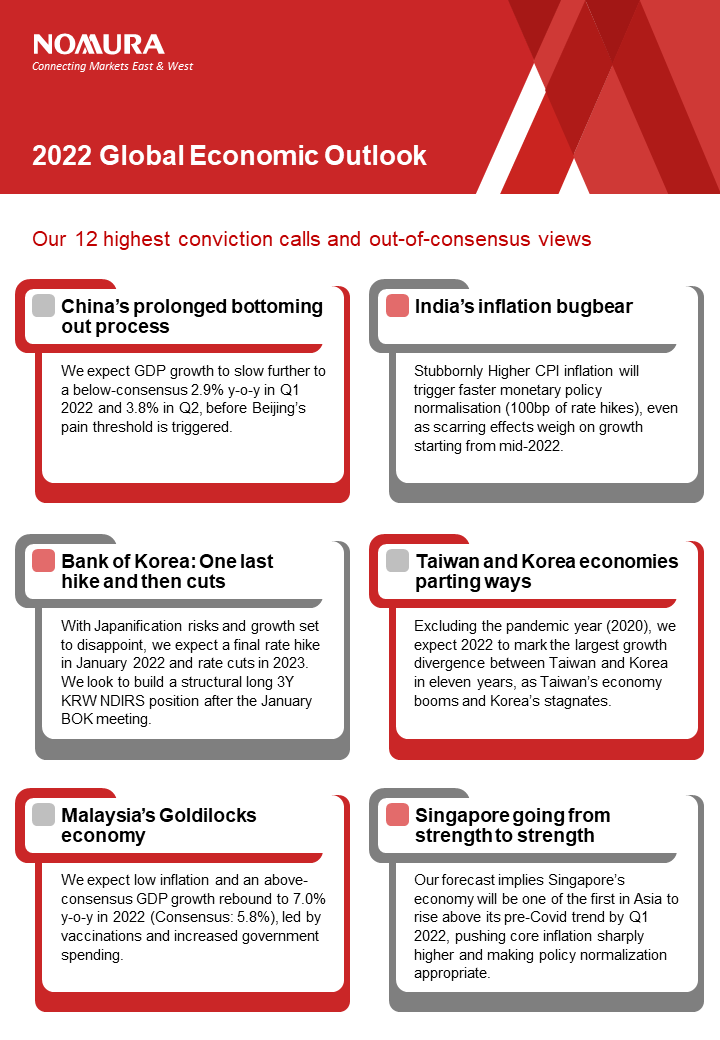Forecasting the economic outlook in 2022 requires much more humility than usual. This is about as uncertain as it gets. We are in unchartered territory, not only on how the sheer size of the global policy response to a once-in-a-lifetime pandemic will be unwound, but also because the nature of the shock has been so unusual; by hitting the demand and supply sides of the economy simultaneously, it makes it doubly difficult to gauge the impacts on growth and inflation. This conflux of events has no historical parallel. And now there is Omicron.
Below we showcase countries performance in GDP for 2022 and our forecast.
US – A potential inflation inflection point: Facing slowing month-on-month inflation, we expect the Fed to remain patient in H1 and then hike rates twice in H2, in September and December. As policy normalization progresses, we expect more intensive debate over the pace of rate hikes, balance sheet policy and the terminal rate. However, should elevated monthly inflation persist, contrary to our expectation, the Fed’s long-held narrative of abating price pressures could collapse, resulting in an earlier, faster and potentially longer hiking cycle to above the neutral rate. We expect real GDP growth to remain robust in H1 2022 but slow sharply in H2, as fiscal stimulus fades and inventory building completes.
China – The worst is yet to come: Despite Beijing’s recent shift in policy stance, we expect growth to weaken further in spring 2022 on a worsening property sector, rising costs of the zero-Covid strategy, an export downturn and widespread factory closures before and during the Winter Olympics. We expect Beijing to take more decisive action to arrest the downward spiral in spring 2022, and growth could bottom out after that. Most raw material prices have already peaked on falling demand, resulting in PPI disinflation and a modest rise in CPI inflation, so we do not expect inflation to be a barrier to policy easing. Beijing’s easing in 2022 would stand in sharp contrast with most other economies.
Europe – policy unwinding despite Omicron: The Omicron threat has led a number of euro area countries to reimpose restrictions that should slow growth early in 2022. But with inflation surging, we expect the ECB to allow a reasonably sharp pace of tapering from spring 2022, and we have brought forward ECB rate-hike lift-off to mid-2023. Politics will be in focus in 2022, with a new German coalition, France’s presidential election and changes at the top in Italy. In the UK, we expect a modest growth slowdown in Q1 but for inflation to persist at exceptionally elevated levels for some months and to remain above target until 2023. The BOE’s response should be to raise rates to an extent similar to past cycles: we see a 1.0% Bank Rate by end-2022, with a couple more hikes beyond.
Japan: Towards a complete reopening of the economy: Overcoming supply constraints and reopening international travel, we expect the almost full normalization of economic activity for Japan to eventually be achieved in 2022. However, the main factors that have kept Japan's inflation momentum low thus far – such as persistently low inflation expectations, Japanese consumers' high price sensitivity and the resultant reluctance of corporations to hike prices – appear to still be in place. It seems unlikely that Japan will experience, even as a temporary blip, the sort of inflation exceeding central banks' inflation targets that has been recently observed in many regions overseas.
India – Durable inflation, non-durable growth: India’s bumpy cyclical recovery in 2021 should continue in H1 2022, even as a still-low vaccination rate increases the risk of virus setbacks. However, we worry about the side effects of loose policies that are visible in the form of high inflation (another year above 5%) and a widening current account deficit. The uneven nature of the recovery has also resulted in scarring effects, hurting the consumption of lower income households, while a sustained capex upcycle is not yet in sight. Overall, we do not see the current growth cycle as durable. With uneven growth, high inflation and wider twin deficits, we expect India’s risk premium to rise, and the RBI to deliver 100bp of cumulative rate hikes, but only after falling behind the curve initially.
Rest of Asia – The export tide is turning: While Omicron has increased uncertainty we see Asia’s bumpy upcycle extending into early 2022, led by reopening and easing supply bottlenecks. However, we expect an export downturn from mid-2022, and are more circumspect on the rotation into domestic demand. Inflation will likely edge higher but, unlike other regions, should generally remain under control, allowing gradualism on monetary policy normalisation. Alongside an export downturn, high debt and scarring effects, we see lower terminal policy rates in this cycle. Relative to consensus, our growth outlook is more positive on Singapore, Malaysia and Taiwan, more negative on South Korea and the Philippines, and cautious on macro risks in Indonesia.
Read our full Global 2021 Economic Outlook - The heat is on... for now report here
















